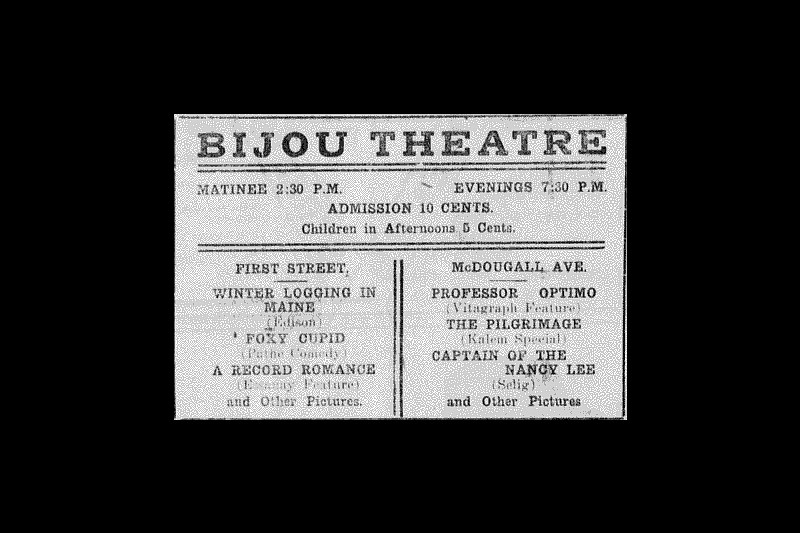On this day in 1912, the Bijou Theatre, Edmonton's first cinema, was advertising its latest showings.
For 10 cents admission, moviegoers would generally be treated to an educational film (in this case, Winter Logging in Maine!), a short comedy, and a full-length feature. There would usually be a bit of an intermission featuring orchestra music or comments by the Bijou's manager as well, which gave the projectionist time to set up the next film reel.
The Bijou Theatre had humble beginnings, starting out of a converted store in downtown Edmonton in 1908. It wasn't the most glamorous experience, with its hard wooden seating and hand-cranked projector. But it didn't matter much — Edmonton audiences were hooked. The city already had a strong tradition of live theatre and quickly embraced the silver screen. But it wasn't just pure entertainment they were interested in. Newsreels and educational films allowed audiences to experience a view of world events that couldn't be found in newspapers or books. For example, when King Edward died in 1910, the film of his state funeral in London was rushed to the Bijou, where it played for six days.
By 1912, the Bijou opened a second location, the South Side Bijou, in Strathcona. Other theatre companies were also moving in, and the increased competition led to entrepreneurs building bigger and grander buildings to set themselves apart. By 1915, Edmonton was home to many large movie theatres; Allen Theatres, one of the earliest movie theatre chains, owned both the Gem and the Monarch, with 490 seats and 600 seats respectively. The Gem was on Jasper Avenue and 96 Street, near where the Dreamland Theatre had opened a couple of years before. Soon after, they were joined by the Portola Theatre a block away, turning the area into Edmonton's first cinema district.
One of the few surviving cinemas of the era, the Princess Theatre, was finished in 1914. The lavish building was said to have the largest stage in Western Canada and focused on a program of "high class moving pictures varied occasionally with high class musical vaudeville or musical concerts." (It's for sale, by the way.)
The rising popularity of movies in Edmonton, and the rest of Alberta, didn't come without its detractors. Theatres didn't have restrictions on what types of films could be shown, and calls rose up from newspapers, government officials, and police departments for films to be censored. Depictions of violence, crime, drinking, and sexual behaviour frequently came up. However, some were also worried that many of the films contained American propaganda or didn't show enough images of Canada or Great Britain to inspire patriotic sentiment. As a result, the Alberta government enacted The Theatres Act in 1913, which regulated movie theatres and required all films shown in them to receive provincial ratings and approval. (Many other provinces set up similar systems around the same time — although Alberta, unlike most others, only regulates theatrical releases.)
Even with the new restrictions, film remained a popular pastime in Edmonton. New theatres continued to open, including another Allen theatre (named, aptly enough, the Allen Theatre) in 1918. The new cinema featured an auditorium that was modelled after a Roman amphitheatre, a state-of-the-art ventilation system, and other creature comforts to lure in audiences. The Allen would eventually become the Capitol Theatre and be converted to show "talkies" in the 1920s, becoming one of Edmonton's most storied film houses into the Golden Age of Cinema during the 1930s and '40s.
Despite their popularity at the time, few of the pre-1920s movie theatres have survived. Many were torn down to make room for more development during the 1950s and '60s. The Capitol Theatre was demolished in 1979, although a recreation of its 1929 version was built in Fort Edmonton Park. The Gem saw itself renamed, renovated, and turned into a restaurant over the decades before being abandoned. It was declared a historic resource in 2000 but was deemed a public hazard and was torn down in 2010. The theatre that started it all, the Bijou, continued on until 1938, before it was renovated and renamed the Rialto Theatre. The next few decades saw more renovations and changes in ownership until it was finally closed in 1987.
Still, while those theatres might be gone, Edmonton's love of cinema remains. Aside from the many modern multiplexes scattered around the city, it is home to countless film societies, clubs, and festivals — including the Edmonton International Film Festival, which opens on Sept. 21.
This is based on a clipping found on Vintage Edmonton, a daily look at Edmonton's history from armchair archivist @revRecluse — follow @VintageEdmonton for daily ephemera.

